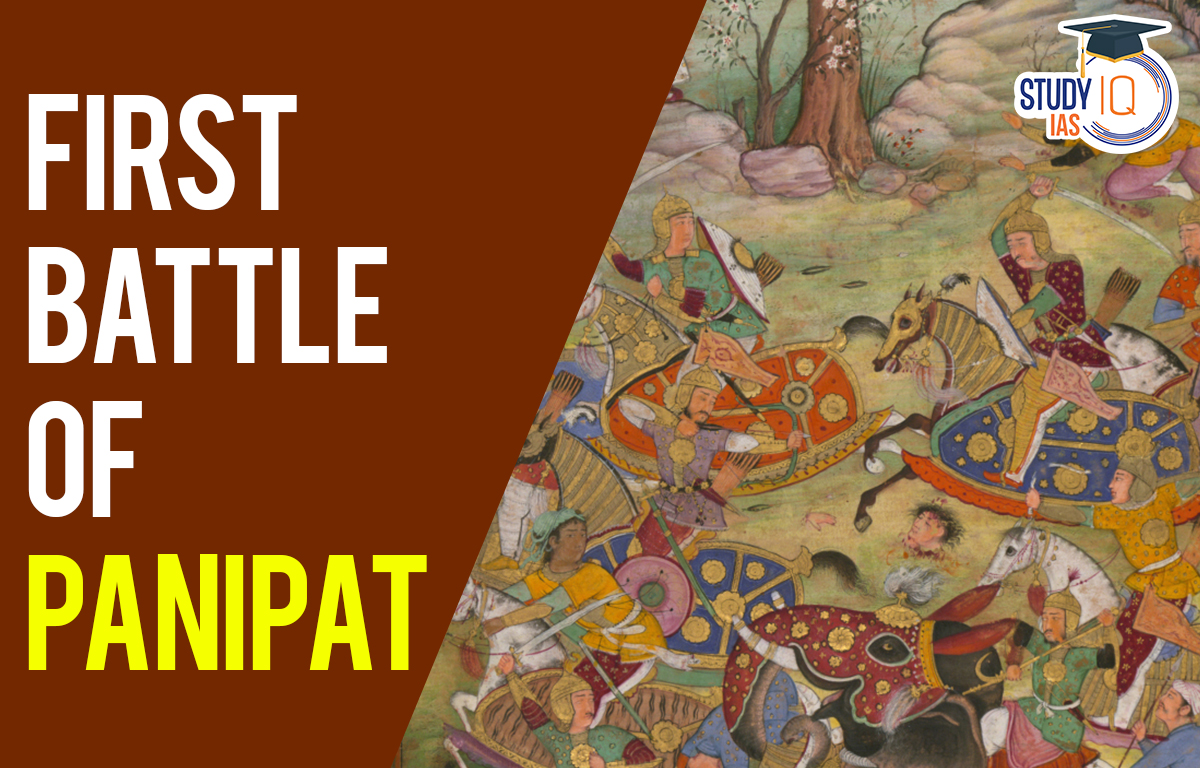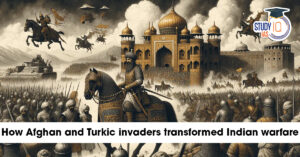Table of Contents
First Battle of Panipat
The First Battle of Panipat was fought on April 21, 1526, between Babur’s invading forces and the Lodi dynasty. It took place in North India and marked the start of the Mughal Empire as well as the end of the Delhi Sultanate. The Mughals were the first to use gunpowder firearms and field artillery in an Indian subcontinent battle. In this article, we will discuss the first Battle of Panipat, which is an important part of the UPSC Syllabus of Medieval History.
Read about: Battle of Buxar
First Battle of Panipat History
On April 21, 1526, the First Battle of Panipat took place in Panipat, a level plain suitable for cavalry movements about 50 miles (80 kilometres) north of Delhi. It was fought between Mughal ruler Babur (Kabul) and Delhi Sultan Ibrahim Lodi. North India was ruled by Ibrahim Lodi of the Lodi dynasty at the time, but the empire was crumbling and there were many defectors.
Daulat Khan Lodi, Governor of Punjab, and Ala-ud-Din, Ibrahim’s uncle, invited Babur. When Babur received the invitation, he dispatched an ambassador to Ibrahim, claiming him to be the rightful heir to the country’s throne, but the ambassador was detained in Lahore and later released.
Babur arrived in Lahore in 1524 but was turned back by Lodi’s troops. He attempted to defeat Lodi once more, this time with the help of another rebel chief, but failed. Babur, on the other hand, was better prepared in 1526, thanks to an improved intelligence network. This led to the first Battle of Panipat in 1526, in Panipat, a level plain suitable for cavalry movements about 50 miles (80 kilometres) north of Delhi.
Read about: Battle of Plassey
First Battle of Panipat Army
Babur’s Mughal forces numbered between 13,000 and 15,000 men, the vast majority of whom were cavalry mounted on horses. His main weapon was a battery of 20 to 24 field artillery pieces, a relatively new innovation in warfare.
Against the Mughals were Ibrahim Lodi’s 30,000 to 40,000 soldiers, as well as tens of thousands of camp followers. Lodi’s primary weapon of shock and awe, according to various sources, was his troop of war elephants, which numbered anywhere from 100 to 1,000 trained and battle-hardened pachyderms.
Read about: List of the Mughal Emperors
Battle of Panipat in Detail
Ibrahim Lodi was no tactician; his army marched out in a haphazard formation, relying on sheer numbers and elephant power to overwhelm the enemy. Babur, on the other hand, used two unfamiliar to Lodi tactics that turned the tide of the battle. Tulughma was the first to divide a smaller force into sections such as forward left, rear left, forward right, rear right, and centre.
The highly mobile right and left divisions peeled out and surrounded the larger enemy force, driving it into the centre of the battlefield. Babur placed his cannons in the centre. The use of carts, known as Araba, was Babur’s second tactical innovation. A row of carts tied together with leather ropes protected his artillery forces, preventing the enemy from getting between them and attacking the artillerymen.
This tactic was previously used by the Ottoman Turks during the Battle of Chaldiran, which is why Babur referred to it as the “Ottoman device.” Babur’s Tulughma formation trapped the Lodi army in a pincher motion.
Because the Lodi’s war elephants had never heard such a loud and terrible noise as that produced by the canons, the terrified animals turned around and ran through their own lines, trampling their own men. Finally, the tyrannical Sultan of Delhi, Ibrahim Lodi, was abandoned by his surviving officers and left to die from his wounds on the battlefield.
Read about: Later Mughal
First Battle of Panipat Result
In 1526, Sultan of Delhi Ibrahim Lodi’s much larger ruling army was defeated by Babur, the Timurid ruler of Kabulistan, effectively ending the Lodi dynasty in India. Although it would take some time for Babur and his successors to gain control of the country, the defeat of the Delhi Sultanate was a significant step towards the establishment of the Mughal Empire, which would rule India until it was defeated by the British Raj in 1858.
Read about: Bahadur Shah I
First Battle of Panipat UPSC
The First Battle of Panipat was fought on 21 April 1526 in North India between the invading forces of Babur and the Lodi Empire. It was the start of the Mughal Empire. This was one of the first battles fought with gunpowder and field artillery. Visit the official website of StudyIQ UPSC online coaching to learn more about the UPSC Exam and subject.
Read about: Muhammad Shah


 Birsa Munda Birth Anniversary 2025: Life...
Birsa Munda Birth Anniversary 2025: Life...
 Military Innovations of Afghans and Turk...
Military Innovations of Afghans and Turk...
 Self-Respect Movement, History, Objectiv...
Self-Respect Movement, History, Objectiv...

























